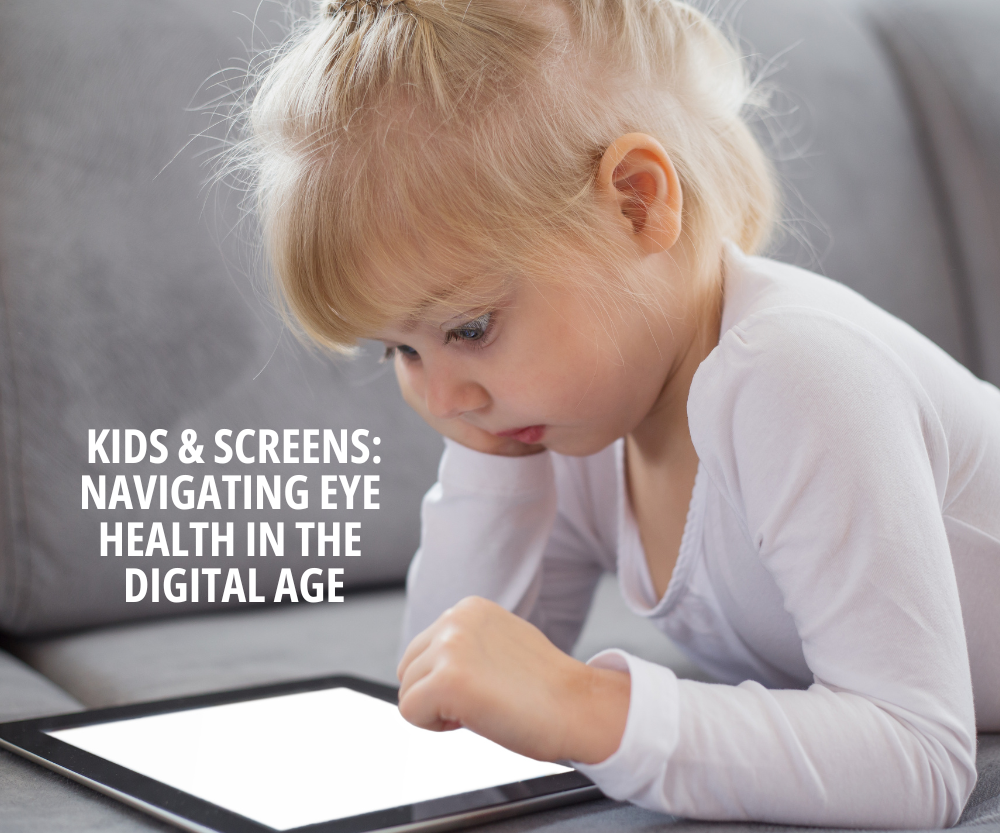 In today’s digital world, screens are an integral part of our children’s daily lives. From educational apps and online learning to entertainment and social interaction, kids are spending more time in front of screens than ever before. As parents, it’s natural to be concerned about the potential impact of this increased screen time on your child’s eye health.
In today’s digital world, screens are an integral part of our children’s daily lives. From educational apps and online learning to entertainment and social interaction, kids are spending more time in front of screens than ever before. As parents, it’s natural to be concerned about the potential impact of this increased screen time on your child’s eye health.
In this blog post, we’ll explore the concerns related to kids and screens, offer practical advice on how to protect young eyes from digital eye strain and discuss the role of blue light and the effectiveness of blue light-blocking glasses.
Understanding Digital Eye Strain
Digital eye strain, also known as computer vision syndrome, is a condition that arises from prolonged use of digital devices. Symptoms can include:
- Eye discomfort
- Dry eyes
- Blurred vision
- Headaches
- Neck and shoulder pain
Children may be particularly vulnerable to digital eye strain because they often spend hours on screens without taking breaks, and their eyes are still developing.
Practical Tips to Protect Young Eyes
1. The 20-20-20 Rule
One of the simplest and most effective ways to prevent digital eye strain is the 20-20-20 rule. This rule suggests that every 20 minutes, your child should take a 20-second break and look at something 20 feet away. This helps relax the eye muscles and reduce strain.
2. Proper Lighting
Ensure that the lighting in your child’s room is adequate. Avoid glare on screens by positioning devices away from windows and using adjustable lighting. A well-lit room reduces the need for the eyes to strain to see the screen.
3. Screen Position
The position of the screen matters. The top of the screen should be at or slightly below eye level, and the screen should be about 20-30 inches away from the eyes. This positioning helps maintain a natural posture and reduces eye strain.
4. Regular Eye Check-Ups
Regular eye check-ups are essential for detecting any vision problems early. Make sure your child has an eye exam at least once a year. If your child complains of frequent headaches, eye discomfort, or trouble seeing, schedule an eye appointment promptly.
The Impact of Blue Light
Blue light is a type of visible light emitted by screens that can penetrate deep into the eye. While blue light exposure from screens is much lower than from natural sunlight, there is growing concern about its impact on eye health, particularly in children.
Potential Effects of Blue Light:
- Digital eye strain
- Disruption of sleep patterns
- Potential long-term damage to the retina
Are Blue Light-Blocking Glasses Effective?
Blue light-blocking glasses have gained popularity as a potential solution to reduce blue light exposure. These glasses are designed to filter out blue light and minimize its effects. However, the effectiveness of blue light-blocking glasses is still a topic of debate among experts.
Pros:
- May reduce digital eye strain
- Can improve sleep quality if worn in the evening
Cons:
- Limited evidence on long-term benefits
- Not a substitute for good screen habits and eye care
Comprehensive Q&A Section
Q1: How much screen time is too much for my child?
A: The American Academy of Pediatrics recommends no more than one hour per day of high-quality programming for children aged 2 to 5 years. For older children, it’s essential to set consistent limits and ensure screen time does not interfere with sleep, physical activity, and other healthy behaviors.
Q2: What are some signs that my child might be experiencing digital eye strain?
A: Signs include frequent eye rubbing, complaints of eye discomfort or headaches, squinting, difficulty focusing, and increased irritability after screen use.
Q3: Should I be worried about blue light from screens affecting my child’s sleep?
A: Yes, blue light can disrupt the production of melatonin, a hormone that regulates sleep. To minimize this effect, encourage your child to avoid screens for at least an hour before bedtime.
Q4: Are there any specific apps or tools that can help manage my child’s screen time?
A: Yes, many apps and tools can help manage screen time, such as Apple’s Screen Time, Google’s Family Link, and various third-party apps like Qustodio and Net Nanny. These tools can help set limits and monitor usage.
Q5: Can adjusting the screen settings help reduce eye strain?
A: Yes, adjusting the screen brightness and contrast to match the lighting in the room can help reduce eye strain. Additionally, enabling “night mode” or “blue light filter” on devices can reduce blue light exposure.
Q6: How often should my child take breaks from screen time?
A: Following the 20-20-20 rule is a good guideline. Encourage your child to take a break every 20 minutes, look at something 20 feet away for 20 seconds, and incorporate longer breaks involving physical activity throughout the day.
Conclusion
As screens continue to play a significant role in our children’s lives, it’s crucial to be proactive about their eye health.
By implementing practical strategies like the 20-20-20 rule, ensuring proper lighting, and scheduling regular eye check-ups, you can help protect your child’s eyes from digital strain. While blue light-blocking glasses may offer some benefits, they should be part of a broader approach to managing screen time and promoting healthy screen habits. Remember, moderation and mindful use of digital devices are key to maintaining your child’s overall well-being in the digital age.
For more personalized advice and eye care solutions, feel free to reach out to Optik Birmingham today. Our team of experts is here to help you navigate the challenges of digital eye health for your family.


